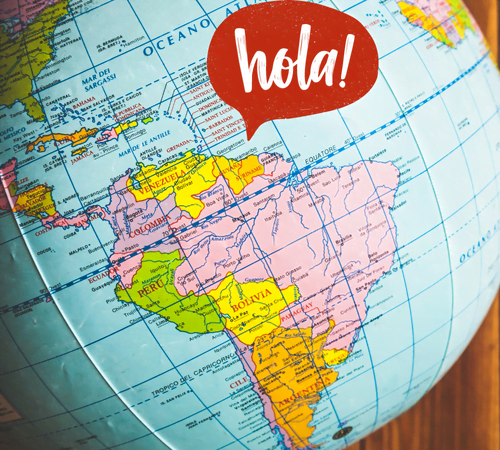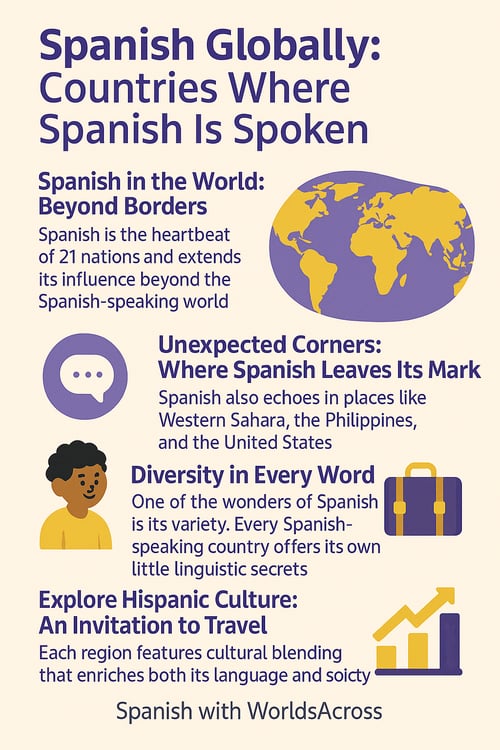Spanish globally: Countries Where Spanish Is Spoken

Did you know that Spanish is much more than just a language? It’s a passport to 21 Spanish-speaking countries—a key that opens doors in places you might not have imagined. As Spanish continues to gain global ground, more and more people are drawn to its charm, melody, and the richness of its words. But where exactly is this language spoken? And more importantly, why should it matter to you?
Spanish in the World: Beyond Borders
When we talk about countries where Spanish is the official language, we're referring to a vibrant and diverse tapestry. From the bustling streets of Buenos Aires to the grand plazas of Madrid, Spanish is the heartbeat of 21 nations. Picture yourself traveling through the Andes in Chile, getting lost in the art scene of Bogotá, or dancing to the rhythm of Cuban son in Havana—all while immersing yourself in the language.
But Spanish's influence doesn’t stop there. The United States, for example, is home to the second-largest Spanish-speaking community in the world, right after Mexico. Yes, that’s how impactful this language is—it’s transcended beyond the Spanish-speaking world into English-speaking countries as well!
Unexpected Corners: Where Spanish Leaves Its Mark
Believe it or not, Spanish also echoes in unexpected places. In the heart of Western Sahara, a territory in Africa with historical ties to Spain, the language can still be heard. And we can't forget the Philippines and the United States—though not fully Spanish-speaking nations, they are part of the Association of Spanish Language Academies. That’s how deep the impact of Spanish goes!
Why Learn Spanish?
With over 567 million speakers, Spanish is the second most spoken language in the world. Every word is an invitation to connect with millions of people.

Diversity in Every Word
One of the wonders of Spanish is its variety. How do you call a child? Depending on where you are, it might be nene in Argentina, chamaco in Mexico, pibe in Uruguay, or carajillo in Spain—and those are just a few examples.
Traveling to Spain? Don’t be surprised if someone refers to a car as a coche. But in Mexico, it would be carro. And while someone in Madrid might say conducir (to drive), in Lima you'll likely hear manejar. Every Spanish-speaking country offers its own little linguistic secrets for you to discover.
Explore Hispanic Culture: An Invitation to Travel
In most Spanish-speaking countries, more than 90% of the population speaks Spanish as their mother tongue. However, in places like Paraguay, Spanish shares the stage with Guaraní, adding another fascinating layer to the linguistic experience. Each region has seen cultural blending that enriches both its language and society. Come explore them!
The Charm of Clear Pronunciation: Where Words Flow Like Water
If you’re looking for places where Spanish is spoken clearly and understandably, some cities stand out for their impeccable pronunciation. Think of the smooth cadence of Bogotá, the melodious rhythm of Medellín, the elegance of Valladolid in Spain, or the clarity and precision of Caracas, Venezuela. These destinations offer a linguistic experience where every word flows, making communication and comprehension much easier.
The Rise of Spanish: A Language on the Rise
In 2020, more than 22 million people began learning Spanish—and that number keeps growing. The pandemic acted as a catalyst for online language learning, and Spanish, with its charm and global utility, was no exception.
Your Gateway to the Spanish-Speaking World: WorldsAcross
If you're determined to learn Spanish quickly, WorldsAcross gives you the opportunity to do so with tutors from Spanish-speaking countries. Imagine learning Spanish with a teacher from Colombia, Argentina, Venezuela, Mexico, or Ecuador—all from the comfort of your home. Whether in group classes or one-on-one sessions, WorldsAcross connects you with the heart of the Spanish-speaking world.



